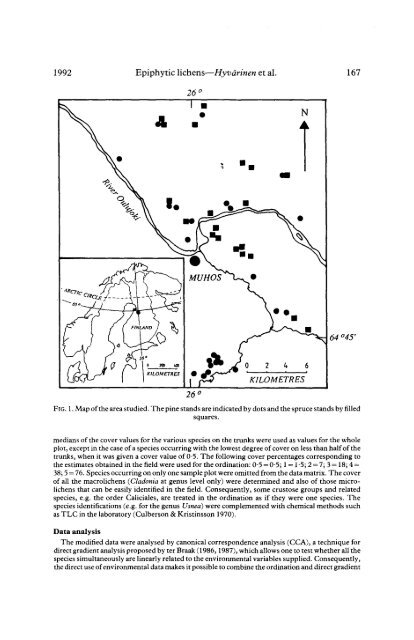Influence of Stand Age And Structure on the Epiphytic Lichen ...
Influence of Stand Age And Structure on the Epiphytic Lichen ...
Influence of Stand Age And Structure on the Epiphytic Lichen ...
You also want an ePaper? Increase the reach of your titles
YUMPU automatically turns print PDFs into web optimized ePapers that Google loves.
1992 <strong>Epiphytic</strong> lichens—Hyvdrinen et al.<br />
167<br />
26°<br />
N<br />
64 °45'<br />
KILOMETRES<br />
FIG. 1. Map <str<strong>on</strong>g>of</str<strong>on</strong>g> <strong>the</strong> area studied. The pine stands are indicated by dots and <strong>the</strong> spruce stands by filled<br />
squares.<br />
medians <str<strong>on</strong>g>of</str<strong>on</strong>g> <strong>the</strong> cover values for <strong>the</strong> various species <strong>on</strong> <strong>the</strong> trunks were used as values for <strong>the</strong> whole<br />
plot, except in <strong>the</strong> case <str<strong>on</strong>g>of</str<strong>on</strong>g> a species occurring with <strong>the</strong> lowest degree <str<strong>on</strong>g>of</str<strong>on</strong>g> cover <strong>on</strong> less than half <str<strong>on</strong>g>of</str<strong>on</strong>g> <strong>the</strong><br />
trunks, when it was given a cover value <str<strong>on</strong>g>of</str<strong>on</strong>g> 0-5. The following cover percentages corresp<strong>on</strong>ding to<br />
<strong>the</strong> estimates obtained in <strong>the</strong> fieldwere used for <strong>the</strong> ordinati<strong>on</strong>: 0-5 = 0-5; 1 = 1-5; 2 = 7; 3= 18; 4 =<br />
38; 5 = 76. Species occurring <strong>on</strong> <strong>on</strong>ly <strong>on</strong>e sample plot were omitted from <strong>the</strong> data matrix. The cover<br />
<str<strong>on</strong>g>of</str<strong>on</strong>g> all <strong>the</strong> macrolichens {Clad<strong>on</strong>ia at genus level <strong>on</strong>ly) were determined and also <str<strong>on</strong>g>of</str<strong>on</strong>g> those microlichens<br />
that can be easily identified in <strong>the</strong> field. C<strong>on</strong>sequently, some crustose groups and related<br />
species, e.g. <strong>the</strong> order Caliciales, are treated in <strong>the</strong> ordinati<strong>on</strong> as if <strong>the</strong>y were <strong>on</strong>e species. The<br />
species identificati<strong>on</strong>s (e.g. for <strong>the</strong> genus Usnea) were complemented with chemical methods such<br />
as TLC in <strong>the</strong> laboratory (Culbers<strong>on</strong> & Kristinss<strong>on</strong> 1970).<br />
Data analysis<br />
The modified data were analysed by can<strong>on</strong>ical corresp<strong>on</strong>dence analysis (CCA), a technique for<br />
direct gradient analysis proposed by ter Braak (1986,1987), which allows <strong>on</strong>e to test whe<strong>the</strong>r all <strong>the</strong><br />
species simultaneously are linearly related to <strong>the</strong> envir<strong>on</strong>mental variables supplied. C<strong>on</strong>sequently,<br />
<strong>the</strong> direct use <str<strong>on</strong>g>of</str<strong>on</strong>g> envir<strong>on</strong>mental data makes it possible to combine <strong>the</strong> ordinati<strong>on</strong> and direct gradient
















